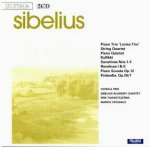This compilation is notable for several excellent performances, although from a programming standpoint it would have made more sense to re-issue all four string quartets and the Piano Quintet, omitting the solo piano pieces. Nevertheless, the Tapiola Trio opens the disc with a spirited reading of Sibelius’ early C major trio Loviisa, and if you don’t mind a top-heavy recording (shrill violin sound on the E-string, brittle piano right hand, and nasal cello) there are some nice moments here, with the dreamy central Andante suggesting how this group might sound when more sympathetically recorded. The Sibelius Academy Quartet’s first recording of the early E-flat major quartet follows. This was made in 1988 but it’s every bit as good as the 1992 remake now forming part of the group’s complete series, available at full price on Finlandia.
Erik Tawaststjerna joins the quartet in the G minor Quintet for piano and strings. This performance has some outstanding qualities, such as the dark-hued solemnity of the opening (Grave) and the formidable virtuosity in the finale. Again, a major caveat is the sound. Tawaststjerna always is the dominant force, and the strings, particularly the two inner voices, seldom come across as powerfully as they should. That’s most apparent in the Intermezzo (movement II), where exchanges of the main ideas among the piano, viola, and cello aren’t well balanced. And the first violin, especially when playing in higher registers, often forces his sound, which becomes shrill and brittle.
The finest moments come in the Andante, where you’ll appreciate the closeness of instrumental dialogue more acutely as the piano assumes a more supportive function, though the Vivacissimo finale is brought off with tremendous energy and virtuosity. In terms of ensemble and intonation, this reading is impeccable and unblemished, significantly eclipsing the 1980 Anthony Goldstone/Gabrielli Quartet version on Chandos.
Disc 2 comprises solo piano pieces in generally commendable performances by Marita Viitasalo. An exception is the Op. 12 sonata, which has neither the technical finesse nor rhythmic incisiveness that mark Ralf Gothoni’s Ondine traversal. For the program’s final work, the piano version of Finlandia, she’s back in fine form, saving special eloquence for the hymn-like middle section.
































